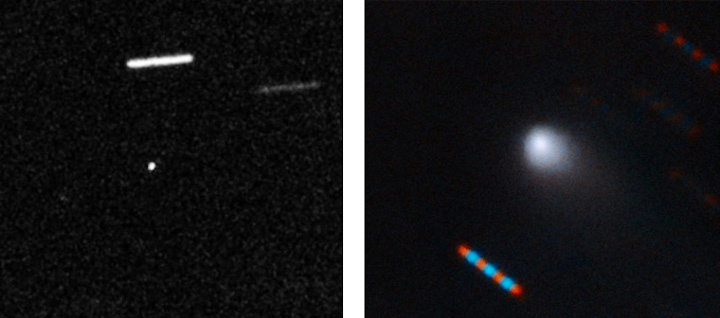15.10.2019

The second mysterious interstellar object found zipping through the solar system, 2I/Borisov, looks like a run-of-the-mill comet. That stands in stark contrast to the first known interstellar object, ‘Oumuamua (illustrated).
The second space rock seen visiting our solar system from another star is proving just how bizarre the first known interstellar object, ‘Oumuamua, really was.
‘Oumuamua raised eyebrows when it appeared in October 2017 looking more like a rocky asteroid than an icy comet (SN: 10/27/17). Because comets form farther from their host stars than asteroids, it should be easier for comets to escape their star’s gravity to wander the galaxy. So astronomers expect the vast majority of interstellar vagabonds to be icy bodies. But ‘Oumuamua didn’t sport the gaseous halo or tail that forms when sunlight vaporizes a comet’s ice.
Now, new telescope images confirm that a second interstellar object called 2I/Borisov (originally dubbed C/2019 Q4 (Borisov)) looks like a garden-variety comet, researchers report online October 14 in Nature Astronomy. The cometlike appearance of this object, first glimpsed August 30, suggests that ‘Oumuamua’s weirdness was a one-off, and that astronomers’ models of planetary systems are on the right track (SN: 9/12/19).
Astronomers observed 2I/Borisov on two nights in September with the William Herschel Telescope in the Spanish Canary Islands and the Gemini North Telescope in Hawaii. Those images reveal that, like comets native to our solar system, 2I/Borisov’s core is shrouded in a gaseous halo trailed by a faint, broad stream of gas and dust.

“It’s kind of relieving that finally we have something that meets our expectations,” says study coauthor Michał Drahus, an astronomer at Jagiellonian University in Kraków, Poland. “Now we really can be absolutely sure that ‘Oumuamua was one weird object.”
Whereas ‘Oumuamua vanished within weeks of its discovery, astronomers have several months to take a closer look at 2I/Borisov. Higher-resolution telescope images may tease out the exact size and shape of its core, and inspecting the specific wavelengths of light emanating from the comet could help astronomers flesh out its chemical composition.
Preliminary wavelength observations have already hinted that 2I/Borisov contains cyanogen gas (made of carbon and nitrogen atoms), which is relatively common in comets native to the solar system. Astronomer Alan Fitzsimmons of Queen’s University Belfast in Northern Ireland and colleagues report these findings October 2 at arXiv.org.
An odd couple
The second known interstellar object, a comet currently cruising through our solar system called 2I/Borisov, looks fairly different from the first discovered interstellar visitor — an asteroid-like object called ‘Oumuamua that skirted by Earth in 2017. Here are some of the key distinctions between this pair of galaxy-trotting space rocks.
Differences between the first and second discovered interstellar objects
| ‘Oumuamua | 2I/Borisov | |
| Constellation of origin | Lyra | Cassiopeia |
| Halo and tail | No | Yes |
| Width | 400 meters | ~2 kilometers |
| Shape | Oblong | Unknown |
| Closest distance to Earth | 0.16 au (astronomical units) | 1.9 au |
| Closest approach to Earth | October 14, 2017 | December 28, 2019 |
| Time observable | Weeks | Months |
Sources: P. Guzik et al/Nature Astronomy 2019, ‘Oumuamua ISSI team/arXiv.org 2019, A.M. Hein et al/Acta Astronautica 2019
Quelle: ScienceNews
